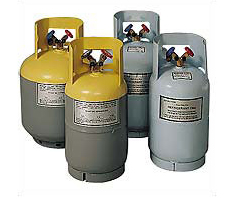 Refrigerants are wondrous for all the industry, essential infrastructure, and basic human comfort that they make possible but there is also a fundamental downside to most refrigerant substances: they can be downright dangerous, if not deadly. Most refrigerants have extremely low boiling points, presenting the dangers of frostbite and eye damage if touched; those with higher boiling points can still cause respiratory and skin irritation.
Refrigerants are wondrous for all the industry, essential infrastructure, and basic human comfort that they make possible but there is also a fundamental downside to most refrigerant substances: they can be downright dangerous, if not deadly. Most refrigerants have extremely low boiling points, presenting the dangers of frostbite and eye damage if touched; those with higher boiling points can still cause respiratory and skin irritation.
Beware Improper Handling
On a global scale, improper handling can lead to their release into the atmosphere, depleting the ozone layer and allowing ultraviolet radiation to deplete our atmosphere. This can cause increased overexposure to UV radiation and lead to skin cancer, cataracts and compromised immune system to name but a few serious maladies.
Make Sure You Follow the Guidelines for Use and Storage
Obviously, these substances obviously need to be carefully and properly maintained and handled so that those in the nearby vicinity and the environment in general are not irrevocably harmed. In general, strict adherence to the guidelines of machinery and containers involved with refrigerants is your first step in knowledge of safe handling, including tools and garb necessary. Maintenance of the machinery is also very essential. Find a custom rubber part manufacturing company if you need custom rubber parts for your machines and equipment. Various commercial lubricants may also be needed to keep the machinery functioning properly and avoid any accidents.
Some Tips For Not Losing Your Cool With Refrigerants
- Employers must ensure that personnel review the MSDS (Material Safety Data Sheet or internationally known as Safety Data Sheet) for particular refrigerants
- Ventilate/test the atmosphere of an enclosed area before beginning work—many refrigerants may be undetectable by human senses, and, since heavier than air, can replace oxygen in an enclosed area and cause loss of consciousness.
- Refrigerant cylinders should never be filled past 80% capacity as liquid expansion may cause them to burst
- Check the I.C.C. cylinder stamp to ensure that a cylinder is safe
- Note the refrigerant number before charging to avoid mixing refrigerants
- Fluorocarbon refrigerants should be treated as toxic—in high concentrations, they can have an anesthetic effect, causing stumbling, shortness of breath, irregular or missing pulse, tremors, convulsions and even death
- Liquid refrigerant may freeze the skin causing frostbite
- Before disassembling a system, make sure all liquid refrigerant is removed and the pressure at 0 p.s.i.
- Do not smoke, braze or weld when refrigerant vapors are present. When brazing or welding refrigeration lines, they should be continuously purged with low-pressure carbon dioxide or nitrogen. When finished, pressure test them with carbon dioxide or nitrogen.
- If refrigerant gets in eyes, immediately wash with mineral oil to absorb the refrigerant, followed by a prepared boric acid solution. (If the refrigerant is ammonia, wash with water for at least 15 minutes and seek medical attention as SOON as possible.)
- Purged refrigerants must not be released into the atmosphere—collect and dispose according to Federal guidelines
- Do not allow refrigerant cylinders storage area temperatures to reach 125 degrees F
- Inspect refrigerant cylinders regularly and do not use if they show signs of rust, distortion, denting, or corrosion
- Securely store cylinders upright in an area where they will not be knocked over or damaged
Need someone to make sense of this for your business? We deal with these issues every day. Contact Us (859-689-9222) to get more information about how we can help your business be less hazardous.
